Friends in focus
Jenny and Guy Oakley’s beautiful Taranaki garden is well known in gardening circles. Their picturesque oasis has been a highlight of the annual Taranaki Garden Festival for the last 36 years.
Jenny began planting her garden nearly 40 years ago, not long after completing her degree in Environmental Horticulture. Back then, birds were not so much on her radar but there were a couple of happy accidents, she says. “A friend gave us a kauri when our eldest son was born. We carried on the tradition when our other two sons arrived. During those early years I also planted a few cabbage trees that I’d collected as seedlings. Both the kauris and the cabbage trees became favourite roosting places for our rurus”.
It was her fascination with that pair of rurus (morepork) that, about ten years ago, led Jenny into photography. “I started taking photos of them because I wanted to prove to myself that they were two different birds, as I never saw them both together. That meant I had to get a better camera. Then I thought, well I may as well be photographing other birds.”
Regular visitors to Jenny and Guy’s garden include silvereyes, fantails, grey warblers, blackbirds, thrush, sparrows, magpies, kingfishers and the occasional tui. “Coastal Taranaki is pretty bereft of trees so we don’t have a wide range of birds and very few tui,” explains Jenny.
“Farmers have spent years taking trees down in South Taranaki, but things are changing. Taranaki Regional Council is doing really well with riparian planting so there are thousands of trees and shrubs being planted on farms now.”
She believes the rurus have always been around and that they are more common than most people realise. “I think it’s just that people don’t know how to find them.” She’s not sure if the two in her garden are a mating pair. She has seen them interact but they don't sit together, unlike another couple she photographs in the nearby bush where she goes pest trapping. “I’m sure those two are a mating pair. They’re always together, which I think is pretty rare.”
Has her interest in birds changed the way she gardens? “Yes,” laughs Jenny. “I go to prune things and then I stop when I remember that’s where the rurus sit!” She is more inclined to plant the likes of kowhai and other food plants these days and is pleased that little silvereyes stay and nest and that there’s enough food around to keep them happy in summer.
In winter she puts fruit and sugar water out for the nectar feeders. Oranges and apples are favourites with the silvereyes. A single tui comes in the winter to eat the banksia flowers. She hasn’t been able to lure it closer yet, but is philosophical about that because, “If you have territorial tui, you don’t see as many of the little birds.”
Jenny says her interest in wildlife has made her look more closely at her garden, and she is grateful to have very good hearing, especially in the spring when there are baby chicks around. “It’s a funny thing - I used to listen to the radio with ear pods in while gardening, but I don’t do that anymore because I think I might miss something!”
One day in August, she got a beautiful shot of little warbler chicks because she could hear them chirping. All day she will listen out for the smaller birds telling the moreporks off.
“They do this thing called mobbing, using their alarm calls. Every bird’s alarm call is different. Sometimes tiny little birds like silvereyes will be doing it, then the grey warblers join in, and if the fantails arrive you can be sure there is a ruru somewhere close. It’s a very subtle noise that you have to listen for.”
The little birds will also tell the kingfishers off, and magpies too. She was not pleased to see a magpie take a swoop at a ruru one day. “I’ve read that you’ll either have aggressive magpies, or not. Our ones nest in the garden, which I didn ’t like at first, but we seem to have come to an agreement and they’re actually quite friendly.
Jenny agrees that birds are great company while gardening, saying, “It doesn’t matter how grumpy I am, if I go and find the rurus and have a little chat to them, I feel much better!”
She believes the calming effect of birdsong is something quite primal. “I read something interesting on the internet the other day - if birds are happy and not threatened, they sing, and that sends a signal to our nervous system. If the birds are chirping, they are relaxed because there are no predators, so we instinctively relax too. Goodness knows whether it’s true or not, but it makes sense to me!”
Working with kiwis
Jenny’s life around birds extends well beyond her own garden. For many years, she and Guy have been involved with predator control in bush reserves around Taranaki and are active volunteers at Rotokare Scenic Reserve near Eltham.
Rotokare is a pest-free sanctuary set around a beautiful lake in thick native bush with public walking tracks. Up until 4 years ago, Rotokare’s volunteers would collect kiwi eggs to send to a hatchery. The chicks would then go on to live in a crèche until large enough for release - an expensive procedure. These days when the population outgrows the 230ha within Rotokare’s predator free fence, adult kiwis are moved to Mount Taranaki and other bush reserves with suitable trapping.
Guy, a retired vet, looks after the health of the birds at Rotokare. Jenny, after five years of training, is a fully trained kiwi handler. “It’s a huge privilege,” she says of the work she does using telemetry gear to find the birds, changing transmitters and helping with translocation of birds. Because the work is on steep hill country, a high level of fitness required. “Some days you can be out there all day and not find the bird.” Jenny likens it to a sport, one she intends to keep on with as long as she possibly can.
Photographing birds in your garden - Jenny’s tips
- To get close enough for photographs, you need to feed the birds or know which plants they are going to be visiting. It’s really handy to have a feeding station close to the house so you can see when they are there.
- Place your feeder in the sun so there is good light, and somewhere where the birds will feel safe, close to shelter and a landing place to escape danger.
- You also need to locate your feeder where you will have a clutter-free background for your photos - some good foliage for example. Another trick is to have plenty of space between the bird feeders and the background, so that you can get a nice bokeh effect - the bird in sharp focus against a blurred background - without having to get too close.
- A feeder that can hang onto a waratah standard is useful, because you can bang it into the ground anywhere, shifting it to where the best light is.
- Jenny’s favourite camera is her Sony RX10. It’s easy to use and is light enough to carry on long walks. As long as the light is good it does just as well as her large, full-frame camera. Of course, the great thing about digital photography is that you can take thousands of photos!
Jenny uses a rustic homemade feeder to bring birds closer to windows, where she can see them from inside the house. She chooses branches with strong stubby bits for attaching fruit and wispy bits for birds to perch on while they wait their turn for a feed. The branches are set into a large yoghurt pot, set in instant concrete, then placed inside a terracotta pot with pumice or pebbles to hold the yoghurt pot in place. She makes it sturdy enough to last several months (or years) of photographic fun. A steel plate attached to a waratah makes a safe perch area for the pot.
Bird plants in Jenny ’s garden
Nectar:
- Abutilon (Chinese lantern)
- Banksia
- Camellias
- Cordyline (cabbage tree)
- Leptospermum (manuka)
- Sophora (kowhai)
- Pittosporum
- Phormium (flax)
- Xeronema (Poor Knights lily)
Berries:
- Astelia
- Aristotelia (wineberry)
- Alectryon (titoki)
- Coprosma
- Corokia
- Griselinia
- Pseudopanax

1-Jun-2024
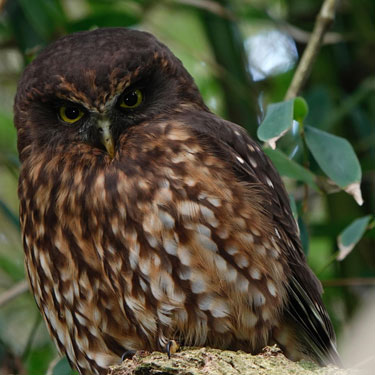
Morepork - Ruru

Silvereye - Tauhou
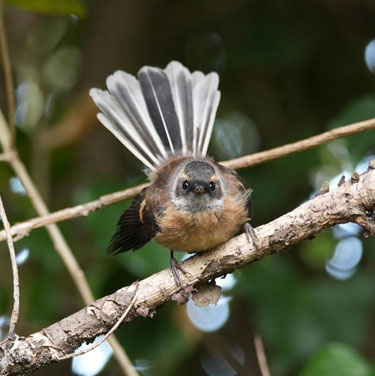
Fantail - Piwakawaka
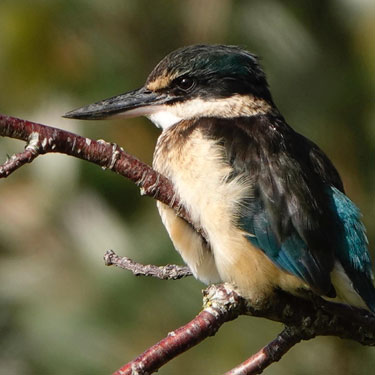
Kingfisher - Kotare
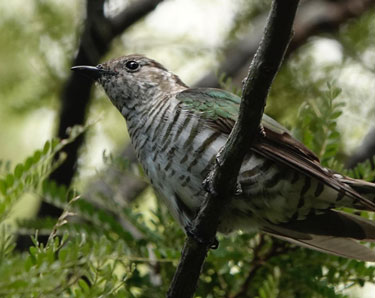
Shining cuckoo - Pipiwharauroa

Nest and eggs of silvereye
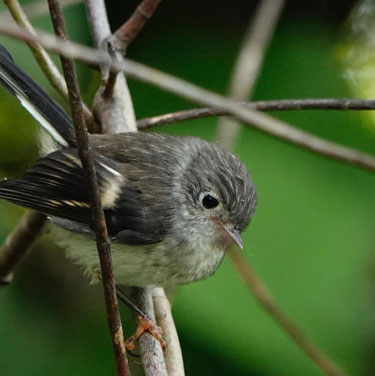
Grey warbler - Riroriro
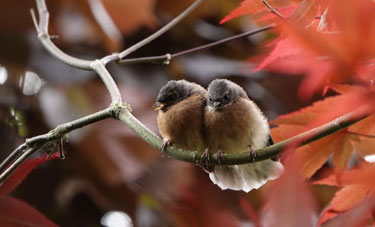
A pair of fledgling fantails

Jenny at work at Rotokare Sanctuary

